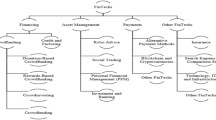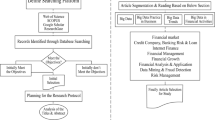Abstract
Although the business environment is stochastic, deterministic data envelopment analysis (DEA) models are typically used to measure the efficiency of commercial banks for the purpose of simplicity. Bank operations are characterized by a network structure due to the dual role of deposits, which, on the one hand, are the output of the process of borrowing funds from depositors and, on the other hand, are the input of the process of making loans. Since the outputs of the production process of the bank are correlated with its inputs, the model for measuring efficiency in this case is a stochastic program with correlated data. To take the correlation between the inputs and outputs into consideration, in this paper, a standard normal transformation is applied for the correlated data, and a network stochastic model is developed to obtain the distribution of the stochastic efficiency. The model is used to measure the efficiency of twenty-two commercial banks in Taiwan. The results are more reliable, discriminative, and informative than those obtained from the existing models. They also show that the performance of a bank is mainly affected by its loan performance. Different from the stereotype suggesting that private companies usually operate more efficiently than state-owned companies, public banks perform better than private banks in Taiwan.



Similar content being viewed by others
References
Aigner, D. J., Lovell, C. A. K., & Schmidt, P. (1977). Foundation and estimation of stochastic frontier models. Journal of Econometrics, 6, 21–37.
Banker, R. D. (1993). Maximum likelihood, consistency and data envelopment analysis: A statistical foundation. Management Science, 39, 1265–1273.
Banker, R. D., Charnes, A., & Cooper, W. W. (1984). Some models for estimating technical and scale efficiencies in data envelopment analysis. Management Science, 30, 1078–1092.
Berger, A. N., & Humphrey, D. B. (1997). Efficiency of financial institutions: International survey and directions for future research. European Journal of Operational Research, 98, 175–212.
Charnes, A., & Cooper, W. W. (1962). Programming with linear fractional functionals. Naval Research Logistics, 9, 181–186.
Charnes, A., Cooper, W. W., & Rhodes, E. (1978). Measuring the efficiency of decision making units. European Journal of Operational Research, 2, 429–444.
Chen, T. Y. (2002). A comparison of chance-constrained DEA and stochastic frontier analysis: Bank efficiency in Taiwan. Journal of the Operational Research Society, 53, 492–500.
Cooper, W. W., Deng, H., Huang, Z. M., & Li, S. X. (2002). Chance constrained programming approaches to technical efficiencies and inefficiencies in stochastic data envelopment analysis. Journal of the Operational Research Society, 53, 1347–1356.
Dutta, P., Jain, A., & Gupta, A. (2020). Performance analysis of non-banking finance companies using two-stage data envelopment analysis. Annals of Operations Research. https://doi.org/10.1007/s10479-020-03705-6.
Eskelinen, J., & Kuosmanen, T. (2013). Intertemporal efficiency analysis of sales teams of a bank: Stochastic semi-nonparametric approach. Journal of Banking & Finance, 37, 5163–5175.
Fethi, M. D., & Pasiouras, F. (2010). Assessing bank efficiency and performance with operational research and artificial intelligence techniques: A survey. European Journal of Operational Research, 204, 189–198.
Financial Supervisory Commission. (2019). The Banking Act of the Republic of China. https://law.moj.gov.tw/ENG/LawClass/LawALL.aspx?pcode=G0380001.
Galariotis, E., Kosmidou, K., Kousenidis, D., Lazaridou, E., & Papapanagiotou, T. (2020). Measuring the effects of M&As on Eurozone bank efficiency: An innovative approach on concentration and credibility impacts. Annals of Operations Research. https://doi.org/10.1007/s10479-020-03586-9.
Gijbels, I., Mammen, E., Park, B., & Simar, L. (1999). On estimation of monotone and concave frontier functions. Journal of the American Statistical Association, 94, 220–228.
Greene, W. (1993). The econometric approach to efficiency measurement. In H. Fried, C. A. K. Lovell, & S. Schmidt (Eds.), The measurement of productive efficiency: Theory and applications (pp. 92–250). NY: Oxford University Press.
Holod, D., & Lewis, H. F. (2011). Resolving the deposit dilemma: A new DEA bank efficiency model. Journal of Banking & Finance, 35, 2801–2810.
Humphrey, D. B. (1985). Costs and scale economies in bank intermediation. In R. C. Aspinwall & R. Eisenbeis (Eds.), Handbook of banking strategy (pp. 745–783). New York: Wiley.
Kao, C. (2009). Efficiency decomposition in network data envelopment analysis: A relational model. European Journal of Operational Research, 192, 949–962.
Kao, C. (2017). Network data envelopment analysis: Foundations and extensions. Bern: Springer International Publishing.
Kao, C., & Hwang, S. N. (2008). Efficiency decomposition in two-stage data envelopment analysis: An application to non-life insurance companies in Taiwan. European Journal of Operational Research, 185, 418–429.
Kao, C., & Liu, S. T. (2004). Predicting bank performance with financial forecasts: A case of Taiwan commercial banks. Journal of Banking & Finance, 28, 2353–2368.
Kao, C., & Liu, S. T. (2009). Stochastic data envelopment analysis in measuring the efficiency of Taiwan commercial banks. European Journal of Operational Research, 196, 312–322.
Kao, C., & Liu, S. T. (2019). Stochastic efficiency measures for production units with correlated data. European Journal of Operational Research, 273, 278–287.
Kneip, A., Park, B., & Simar, L. (1998). A note on the convergence of nonparametric DEA estimators for production efficiency scores. Econometric Theory, 14, 783–793.
Kuosmanen, T., & Kortelainen, M. (2012). Stochastic non-smooth envelopment of data: Semi-parametric frontier estimation subject to shape constraints. Journal of Productivity Analysis, 38, 11–28.
Lampe, H. W., & Hilgers, D. (2015). Trajectories of efficiency measurement: A bibliometric analysis of DEA and SFA. European Journal of Operational Research, 240, 1–21.
Land, K., Lovell, C. A. K., & Thore, S. (1993). Chance-constrained data envelopment analysis. Managerial and Decision Economics, 14, 541–554.
Liu, J. S., Lu, L. Y. Y., Lu, W. M., & Lin, B. J. Y. (2013). A survey of DEA applications. Omega, 41, 893–902.
Lozano, S. (2016). Slacks-based inefficiency approach for general networks with bad outputs: An application to the banking sector. Omega, 60, 73–84.
Meeusen, W., & van den Broeck, J. (1977). Efficiency estimation from Cobb–Douglas production function with composed error. International Economic Review, 8, 435–444.
Olesen, O. B., & Petersen, N. C. (1995). Chance constrained efficiency evaluation. Management Science, 41, 442–457.
Olesen, O. B., & Petersen, N. C. (2016). Stochastic data envelopment analysis—A review. European Journal of Operational Research, 251, 2–21.
Ouenniche, J., & Carrales, S. (2018). Assessing efficiency profiles of UK commercial banks: A DEA analysis with regression-based feedback. Annals of Operations Research, 266, 551–587.
Paradi, J. C., & Zhu, J. (2013). A survey on bank branch efficiency and performance research with data envelopment analysis. Omega, 41, 61–79.
Premachandra, I. M., Zhu, J., Watson, J., & Galagedera, D. U. A. (2012). Best-performing US mutual fund families from 1993 to 2008: Evidence from a novel two-stage DEA model for efficiency decomposition. Journal of Banking & Finance, 36, 3302–3317.
Puri, J., Yadav, S. P., & Garg, H. (2017). A new multi-component DEA approach using common set of weights methodology and imprecise data: An application to public sector banks in India with undesirable and shared resources. Annals of Operations Research, 259, 351–388.
Schmidt, P. (1985). Frontier production functions. Econometric Reviews, 4, 289–328.
Sealey, C. W., & Lindley, J. T. (1977). Inputs, outputs, and a theory of production and cost at depository financial institutions. The Journal of Finance, 32, 1251–1266.
Seiford, L. M., & Zhu, J. (1999). Profitability and marketability of the top 55 US commercial banks. Management Science, 45, 1270–1288.
Simar, L., & Wilson, P. W. (1998). Sensitivity of efficiency scores: How to bootstrap in nonparametric frontier models. Management Science, 44, 49–61.
Simar, L., & Wilson, P. W. (2000). A general methodology for bootstrapping in nonparametric frontier models. Journal of Applied Statistics, 27, 779–802.
Simper, R., Hall, M. J., Liu, W., Zelenyuk, V., & Zhou, Z. (2017). How relevant is the choice of risk management control variable to non-parametric bank profit efficiency analysis? The case of South Korean banks. Annals of Operations Research, 250, 105–127.
Tziogkidis, P., Matthews, K., & Philippas, D. (2018). The effects of sector reforms on the productivity of Greek banks: A step-by-step analysis of the pre-Euro era. Annals of Operations Research, 266, 531–549.
Wang, T. (2015). Competition and increasing returns to scale: A model of bank size. Economic Journal, 125, 989–1014.
Zervopoulos, P. D., Sklavos, S., Kanas, A., & Cheng, G. (2019). A multi-parametric method for bias correction of DEA efficiency estimators. Journal of the Operational Research Society, 70, 655–674.
Acknowledgements
This research was partially supported by the Ministry of Science and Technology of the Republic of China (Taiwan) under Grants MOST108-2410-H-006-102-MY3 and MOST108-2410-H-238-002-MY2.
Author information
Authors and Affiliations
Corresponding author
Additional information
Publisher's Note
Springer Nature remains neutral with regard to jurisdictional claims in published maps and institutional affiliations.
Appendix
Appendix
1.1 List of symbols
- \( e_{k}^{S} \) :
-
Stochastic system efficiency for DMU k
- \( \bar{e}_{k}^{S} \) :
-
Expected value for \( e_{k}^{S} \) with t replications
- \( e_{k}^{(p)} \) :
-
Stochastic pth division efficiency for DMU k
- \( \bar{e}_{k}^{(p)} \) :
-
Expected value for \( e_{k}^{(p)} \) with t replications
- \( E_{k}^{S} \) :
-
System efficiency for DMU k
- \( E_{k}^{(p)} \) :
-
pth division efficiency for DMU k
- \( R_{j}^{(p)} \) :
-
Multivariate normal distribution of the pth division for DMU j
- \( s_{k}^{(S)} \) :
-
Slack variable of the system for DMU k
- \( s_{k}^{(p)} \) :
-
Slack variable of the pth division for DMU k
- \( u_{0} \) :
-
Total value of returns-to-scale for q divisions
- \( u_{0}^{(p)} \) :
-
Value of returns-to-scale for the pth division
- \( u_{r} \) :
-
Weight of exogenous output r
- \( v_{i} \) :
-
Weight of exogenous input i
- \( w_{f} \) :
-
Weight of endogenous input f
- \( w_{g} \) :
-
Weight of endogenous output g
- \( X_{ij} \) :
-
Exogenous input i consumed by DMU j
- \( Y_{rj} \) :
-
Exogenous output r produced by DMU j
- \( Z_{fj} \) :
-
Endogenous input f consumed by DMU j
- \( Z_{gj} \) :
-
Endogenous output g consumed by DMU j
- \( \upalpha_{k} \) :
-
Constant for the adjustment of the system efficiency \( E_{k}^{S} \) for DMU k
- \( \bar{\upalpha }_{k} \) :
-
Expected value for \( \upalpha_{k} \) with t replications
- \( \upbeta_{k}^{(p)} \) :
-
Constant for the adjustment of the pth division efficiency for DMU k
- \( \bar{\upbeta }_{k}^{(p)} \) :
-
Expected value for \( \upbeta_{k}^{(p)} \) with t replications
- \( \zeta_{j}^{(p)} \) :
-
Standard normal random variable of the pth division for DMU j
- \( \upmu_{ij}^{X} \) :
-
Expected value of exogenous input \( X_{ij} \)
- \( \upmu_{rj}^{Y} \) :
-
Expected value of exogenous output \( Y_{rj} \)
- \( \upmu_{fj}^{Z} \) :
-
Expected value of endogenous input \( Z_{fj} \)
- \( \upmu_{gj}^{Z} \) :
-
Expected value of endogenous output \( Z_{gj} \)
Rights and permissions
About this article
Cite this article
Kao, C., Liu, ST. Stochastic efficiencies of network production systems with correlated stochastic data: the case of Taiwanese commercial banks. Ann Oper Res 315, 1151–1174 (2022). https://doi.org/10.1007/s10479-020-03879-z
Accepted:
Published:
Issue Date:
DOI: https://doi.org/10.1007/s10479-020-03879-z




